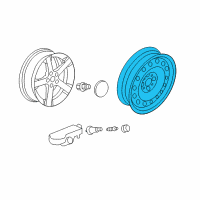< Back ×
2004 Cadillac Seville Alloy Wheels
My Vehicle Change Vehicle
2004 Cadillac Seville
< Back to View All
Wheels & Related Parts
- Department
- Prices
- $118.62 MSRP:
$178.97You Save: $60.35 (34%)Product Specifications- Notes: All
- Other Names: Compact Spare, Spare Wheel, Wheel Spare
- Item Dimensions: 26.1 x 17.5 x 6.8 inches
- Item Weight: 21.60 Pounds
- Fitment Type: Direct Replacement
- Part Description: Wheel, Spare
FAQ for Alloy Wheels Repair
Q: What is the inspection procedure for the tire?
A:
The proper way to inspect the tire is to inspect the front tire wear, inspect the rear tire wear and inspect the struts or the shock absorbers if the tire tread exhibits a cupped appearance.
By Bob
GM Specialist
01/11/2022Q: What special tool will I be needing when servicing the Wheel Bearing/Hub?
A:
You will be needing wheel hub remover.
By Bob
GM Specialist
01/11/2022Q: Is it necessary to wear gloves when inspecting the tires?
A:
Yes, you should wear gloves when inspecting the tires to prevent personal injury from steel belts sticking through the tire.
By Bob
GM Specialist
01/11/2022Q: Will there be any personal injury when inflating the tire, and what should be noticed when inflating the tire?
A:
To avoid serious personal injury, do not stand over the tire when inflating. The bead may break when the bead snaps over the safety hump. Do not exceed 275 kPa (40 psi) pressure when inflating any tire if beads are not seated. If 275 kPa (40 psi) pressure will not seat the beads, deflate, relubricate the beads and reinflate. Overinflation may cause the bead to break and cause serious personal injury.
By Bob
GM Specialist
01/11/2022Q: What are the recommended torque for the wheel bearing and hub retaining bolts?
A:
The recommended torque is 130 Nm (95 ft. lbs.).
By Bob
GM Specialist
01/11/2022Q: What should be noticed when servicing the Aluminum Wheel?
A:
Do not damage the exterior surface of the wheel.
By Bob
GM Specialist
28/10/2022Q: What is the finish damage evaluation procedure for the aluminum wheel?
A:
You should inspect the wheels for damage, verify the damage is not deeper than what sanding can remove, and inspect the wheels for cracks. if a wheel has cracks, discard the wheel and inspect the wheels for bent rim flanges. If a rim flange is bent, discard the wheel.
By Bob
GM Specialist
28/10/2022See more FAQs (2)

